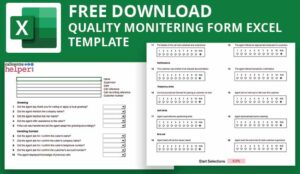David Geffen of NICE discusses the value of contact centre quality assurance (QA) and questions whether you are using it to drive the right behaviours.
Executive management wants to know what effect their call centre quality programme is having on the organization. Is it contributing to company growth? Is it helping to detect problems, uncover opportunities, and increase customer satisfaction? In what way and by how much?
Call centre supervisors want to be able to show their teams are making a measurable difference. Performance metrics such as Average Hold Time (AHT) and First Call Resolution rate (FCR) are considered the gold standard for measuring how efficient and productive call centre agents can be.
But when the focus is only on those measures, you may not be getting a true picture of agent performance or the best experience for your customers.
Call Centre Evaluation: Are You Driving the Right Behaviours?
Agents trying to reduce their Average Handle Time may be inclined to rush their calls and pressurize customers into making decisions quickly.
Likewise, to raise their FCR score, agents often need to spend more time on the line in order to understand and resolve an issue to the complete satisfaction of the customer.
To agents, it often seems like AHT and FCR are at odds with one another when it comes to providing quality service.
While AHT and FCR remain powerful KPIs, there are additional aspects of the call centre evaluation that can paint a more accurate picture of agent performance.
Providing data-driven feedback to agents on behaviours such as call centre etiquette or problem-solving ability allows agents to be more in control of their own performance and more motivated to engage and improve.
Best Practices for Call Centre Evaluation
Organizations that want to see measurable returns from the dollars invested in call centre quality programmes would be wise to implement these best practices for call centre evaluation:
- Make sure you are measuring the right KPIs to achieve your call centre quality goals
- Use business intelligence (BI) to bring all that data together into a meaningful performance scorecard for each agent
- Leverage your BI to create structured and personalized quality programmes tailored to the strengths and weaknesses of each agent
Call Centre Evaluation: Measure the Right KPIs
Measuring the right call centre KPIs is critical to getting the results you want. Call centre KPIs should drive agent behaviours that increase efficiency, optimize customer experience, and grow revenue.
Since many call centre evaluation processes are still manual, agents often complain that evaluators are too focused on a single KPI or randomly cherry-pick a tiny sample of their interactions for evaluation – failing to see the thriving forest for the few scraggly trees.
Today’s organizations collect an overwhelming amount of data on agent performance.
A standard call centre may measure customer survey results, first contact resolution, average wait time, conversion rates, calls per hour, abandon rates, average handle time, call wrap-up, forecast accuracy, cost per call, agent attrition and absenteeism, call sentiment, quality scores, and more.
To be useful, all of this data needs to be combined intelligently, creating a full picture of call centre performance. Only then can you determine which KPIs are driving the right behaviours to achieve company goals. The importance of business intelligence in achieving this goal cannot be overstated.
Call Centre Evaluation: Bring All Your Data Together Intelligently
A professional call centre needs maximum information to assess operational effectiveness and to get an accurate picture of its current position and where its opportunities and challenges lie.
Your call centre should be analyzing each KPI metric, as well as the interplay between them, for each agent. For example, one agent in your call centre handles many more calls per hour than the other agents.
His AHT is the lowest and his wrap-up work is completed in the least amount of time. For this he is given high marks. But when we look at his feedback surveys, customers are not overly satisfied or willing to recommend your brand.
How can that be?
When you bring all performance metrics together in an integrated fashion, powerful analytics can be applied to investigate issues like these. The combination of multiple metrics plus the possible correlation between them can tell you a lot more than an isolated measurement can.
Turns out, this “super” agent does almost all the talking and structures the conversation to elicit yes/no answers from callers without allowing them to indulge in lengthy answers or explanations.
While each call is finished quickly, many customers are left with a nagging feeling that their issues were not fully understood, and they wonder if they made the right decision.
Perhaps this agent can benefit from personal coaching on call centre etiquette. Likewise, armed with this insight, the organization can adjust the way its metrics are weighted and scored in order to promote agent behaviours and performance that contribute to corporate KPIs.
Turn Call Centre Evaluation Into a Plan of Action
Bringing data together and gaining insight is valuable only if you are able to act and operationalize the opportunities you discover.
Knowing what each agent must do to improve performance and being able to implement such a programme is key to achieving your business goals.
The best programmes for driving performance and recommending tasks should be able to identify specific employees who need assistance, and the metrics they should work on.
Transparency is critical here. Agents who can see and track their own metrics trust they are being evaluated fairly. So much so, they’re often motivated to self-evaluate and seek out coaching in order to improve their scorecard.
The programme should be measurable, defining objectives and interim milestones to be achieved. Good programmes recommend explicit tasks that will help agents adapt their behaviour and achieve their objectives.
Involve the agent to make sure the plan is relevant and be willing to tweak it based on their perspective. Nothing motivates like time, so make tasks and programme milestones time-bound. That way, agents and evaluators can gauge progress and adjust the programme if needed.
This blog post has been re-published by kind permission of NICE – View the Original Article
For more information about NICE - visit the NICE Website
Call Centre Helper is not responsible for the content of these guest blog posts. The opinions expressed in this article are those of the author, and do not necessarily reflect those of Call Centre Helper.
Author: NICE
Published On: 24th Sep 2019
Read more about - Guest Blogs, NICE






 NICE is a leading global enterprise software provider that enables organizations to improve customer experience and business results, ensure compliance and fight financial crime. Their mission is to help customers build and strengthen their reputation by uncovering customer insight, predicting human intent and taking the right action to improve their business.
NICE is a leading global enterprise software provider that enables organizations to improve customer experience and business results, ensure compliance and fight financial crime. Their mission is to help customers build and strengthen their reputation by uncovering customer insight, predicting human intent and taking the right action to improve their business. 































